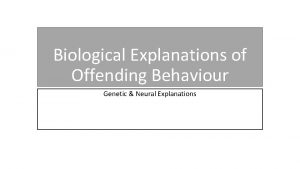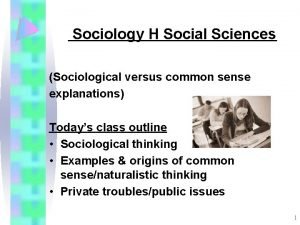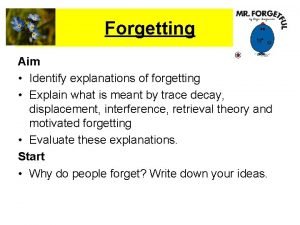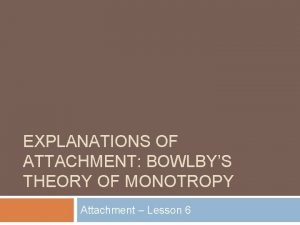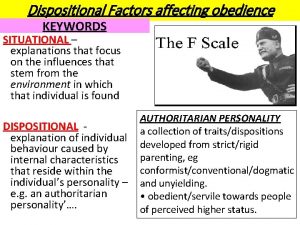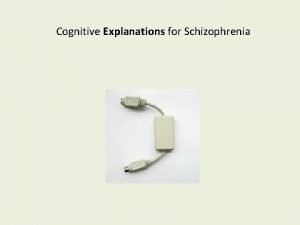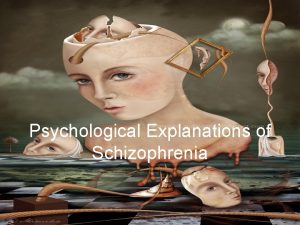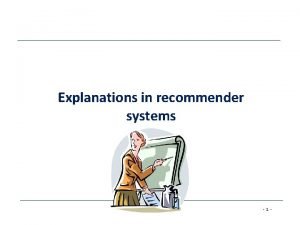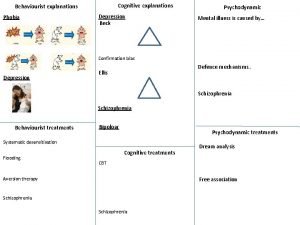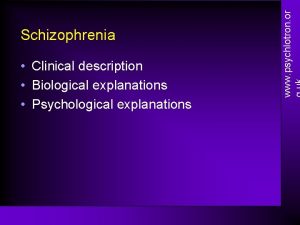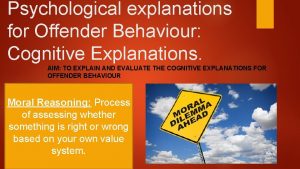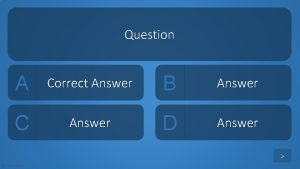Neural explanations Homework Complete the handouts and answer






















- Slides: 22

Neural explanations

Homework • Complete the handouts and answer the questions on: – Scientific process – Role of peer review Research methods (2/10) at lunch time.

This week 1. Neural explanations 2. Dealing with offender behaviours 3. Gender and culture bias


Motor area Somatosensory area l a t Broca’s area n o Fr e b Lo Parietal L obe e b o L l a or p m Te Auditory area Wernicke’s area Visual area Occipital lobe

https: //www. youtube. com/watch? v=Eca. DSJ 1 Lpl. Q https: //www. youtube. com/watch? v=wzqmb. Z 3 g. Z 9 E

Describe the functions of the following areas/neurotransmitters: Brain physiology: Limbic system/way the brain develops • • Frontal lobe Limbic system Amygdala Hippocampus Thalamus Seretonin Dopamine.

Describe the functions of the following areas/neurotransmitters: Frontal lobe: controls actions and feelings (emotions). It is part of the reasoning and higher cognitive functions, and stores long-term memories not associated with learned actions Limbic system: emotions, memories and arousal Amygdala: emotional learning and social learning (ability to feel fear and pleasure) Hippocampus: regulates emotions. The hippocampus is associated mainly with memory, in particular long-term memory Thalamus: regulate the body's voluntary motor control, consciousness and its sleep/wake cycle. It also regulates the senses of sight, sound, taste, touch and the sense of where the person's body is in space Seretonin: sleep, temperature regulation, sexual behaviour, appetite, learning, memory, endocrinal functions, anxiety, depression, moods Dopamine: reward, attention, short-term memory tasks, planning, and motivation.

Problems processing emotions could lead to a lack of guilt/remorse Fault in limbic system could lead to a lack of emotional reactions The amygdala is an almond shaped structure in the limbic system. This is area is important for generating emotions, particularly fear. It has been found that there are important differences in the activity in the left and right amygdala (reduced activity on the left and increased activity on the right)


Biological explanations www. youtube. com/watch? v=Pc 4 j 9 STcl. Rk As you watch the video, answer the following questions on your handout

Task Read Raine’s study and add the main points to the neural explanation sheet. Consider the following evaluation points and add to your handout. Psychology as a science Generalisability Predictive Validity Internal Validity

Raine et al. (1997) Evaluation + Ethics – The participants participated under protocols and consent forms approved by the Human Subjects Committee of University of California, Irvine, meaning that participants were protected from harm and gave informed consent. + Internal Validity – the use of a matched control group increases the internal validity of Raine et al. (1997). – Generalisability – the participants were all from California which means it may be difficult to generalise the results to the wider population and murderers who have plead not guilty by reason of insanity in different geographic areas because there may be something specific about Californians which caused the results. + Predictive Validity – the statistical significance of the results and the high number of controls use in this study suggests that the results may be used to predict individuals which may be predisposed to commit murder and then plead not guilty by reason of insanity. + Psychology as a science – Raine et al. (1997) provides support for the debate psychology as a science. This is because it is a highly controlled, nomothetic laboratory study, which has falsifiable measures. – Socially Sensitive Research – because this study by Raine, has used Murderers who have plead not guilty by reason of insanity, this study may be considered socially sensitive.

Neurotransmitters and criminal behaviour. • Dopamine has been linked to aggression, addiction and substance abuse. It therefore, has a link to criminal behaviour. • Serotonin has been linked to aggression, mood anti social behaviour. It has been found that low levels of serotonin is linked to higher levels of aggression and anti social behaviour. ADD to your information sheet

Evaluation (page 31) • • • Evaluate the area as a whole: Scientific methodology Natural/quasi experiments Why is the damage present? Could it be due to abuse, diet, lack of stimulation, shaken baby syndrome? Are the neurotransmitter imbalances a cause or effect? Correlational research.

Interesting 8. 5% of the US population report having suffered from a head injury. 60% of inmates in US prisons report having suffered a head injury. Nature or Nurture?

Individually come up with an excellent – Level 4 evaluation point of biological explanations • Biological determinism • Strengths and weaknesses of research (method) • Nature vs. nurture

Interactionist approach to offender behaviour POINT: If genetics or brain structure do have some influence on offending, it seems likely that this is at least partly comes about through the combination of genetic predisposition and an environmental or psychological trigger. EXPLAINE: For example being raised in a dysfunctional environment or having criminal role models could be the trigger for the individual committing crime. EVIDENCE This idea is illustrated in the low concordance rates in genetic studies suggesting that genes play a minimal part in the development of that particular characteristic, e. g. criminal behaviour. Low concordance rates suggest environmental factors may be responsible or at least partly responsible for criminal behaviour. LINK: The diathesis-stress model could be used to explain criminal behaviour where concordance rates for MZ twins are not 100%; genes create a vulnerability or predisposition towards criminal behaviour combined with stressors and experiences in the environment acting as a trigger for criminal behaviour.

Biological reductionism One criticism of neural explanations of offending behaviour is that they can be considered reductionist. For example, where researchers look at the way a neurotransmitter or brain region might contribute to offending behaviour, they are overlooking other important factors, such as how the environment might have an impact on these areas as well. That being said, such researchers will argue that to be reductionist allows a more straightforward investigation to be conducted as it would be nearly impossible to disentangle all of the possible explanations and their interactions and investigate them scientifically. This is important to consider as while reducing complex behaviour to its simplest form does require researchers to overlook key factors, it is also essential for good scientific practice.

Practical applications Lombroso’s theory and research had clear implications for the criminal justice system. If offenders are, as Lombroso argues, not responsible for their crimes then how should they be punished, particularly if they cannot control their actions due to their physical make up? Charles Whitman On 1 st August 1966, Whitman murdered his wife and his mother and then climbed a tower on the campus of the University of Texas where he was studying, and shot 45 people, killing 13. During the ensuing shoot-out with law enforcement, he was shot and killed by a police officer. Later, notes written by Charles were discovered around his house, including one which read; "It was after much thought that I decided to kill my wife, Kathy…I love her dearly…I cannot rationally pinpoint any specific reason for doing this". A post-mortem of Whitman’s brain found a tumour the size of a walnut pressing on his amygdala. The conclusion was drawn that perhaps this was the cause of his sudden extreme violence, since the amygdala has been linked to aggression and emotion regulation. But if this is the case, where does the responsibility lie?

Modal essay • Read through the essay. – Bullet point A 01. – Highlight PEEL structure • Plan an answer to the following title: Discuss Biological explanations of offending behaviour (16 marks)

Further reading https: //www. theguardian. com/science/2013/m ay/12/how-to-spot-a-murderers-brain http: //www. wsj. com/articles/SB 1000142412788 7323335404578444682892520530
 Neural explanations of offending behaviour
Neural explanations of offending behaviour Common sense and sociological explanations
Common sense and sociological explanations Arguments and explanations
Arguments and explanations New deal political cartoons and explanations
New deal political cartoons and explanations Russian revolution cartoon
Russian revolution cartoon Epq spec
Epq spec Advantages and disadvantages of handouts
Advantages and disadvantages of handouts Disadvantages of newspaper
Disadvantages of newspaper Homework oh homework
Homework oh homework Homework oh homework i hate you you stink
Homework oh homework i hate you you stink Jack prelutsky homework oh homework
Jack prelutsky homework oh homework Homework oh homework i hate you you stink
Homework oh homework i hate you you stink Alitteration definition
Alitteration definition Literal language
Literal language Zoo103 handouts pdf
Zoo103 handouts pdf Jane schaffer handouts
Jane schaffer handouts Explanations for forgetting
Explanations for forgetting Bowlby's monotropic theory tutor2u
Bowlby's monotropic theory tutor2u Dispositional factors of obedience
Dispositional factors of obedience Cognitive explanations of schizophrenia
Cognitive explanations of schizophrenia Slide samples
Slide samples Wie handout gestalten
Wie handout gestalten Cs408 handouts
Cs408 handouts
